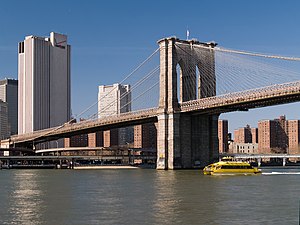New York City currently has about 50,000 homeless people (nearly 8% of the U.S. total), as well as considerable poverty and unemployment. But, quietly, for the last quarter-century, the non-profit group The Doe Fund has operated a highly effective one-year program to move them from despair on the streets to contentment and comfort in homes and at jobs.
A 2010 Harvard study found that people who spent a year in The Doe Fund program were far less likely to commit violent felonies than others just released from prison.
Hamilton Nolan, writing in Gawkr explains:
They take in homeless people, referred to them by places like Bellevue Hospital. Many of these people are fresh out of prison, with little safety net. They house them. They ensure they’re sober and make them abide by a schedule. They give them a job for starters—cleaning up trash around the city, for a month.
After that, the fund gives them classes in life skills and specific job training (they can choose between pest control, catering, building maintenance, and other specialties) for the next six months or so. There are mock job interviews, to get the pitch right. Then they send each one out to pound the pavement and find a job. When they find a job, they find them a place to live.
About 25 years ago, George McDonald (social activist turned politician who is running for mayor but unlikely to win) was shocked to learn of the winter death of a homeless woman in the heart of Manhattan, right outside Grand Central station. For the next two years he went to the corner of 43rd St. and Vanderbilt, at 10 p.m., to feed homeless people. This was during the massive mid-80s crack epidemic, when mounds of vials covered the streets. During the time McDonald ran his ad hoc and officially unsanctioned program, he was frequently arrested for being a nuisance (disorderly conduct).
He obtained a city contract for his homeless people to work on city-owned apartment buildings, and he arranged free city housing for 70 of them in Brooklyn’s Bedford-Stuyvesant district.
Today the program has 700 formerly homeless workers residing in its facilities in Harlem, Bed-Stuy and Brooklyn’s Bushwick neighborhood. They staff their own businesses, including a pest-control firm. At one point, during the Giuliani mayorship, their budget was cut in half, although today it has risen to $50 million/year.
Currently they are seeing many more military veterans and psychologically damaged adults who are former crack babies. The Doe fund has expanded and now operates a similar program in Philadelphia.
‘Doe Fund runs a deliberate, rule-based, common sense, step-by-step process that successfully solves society’s thorniest social and economic problems. At any given time, 700 people are making their way through this process, on a yearlong journey from Having Nothing to Having Something.
All of it exists because George McDonald—just some guy, really, not a radical revolutionary or professional camera-hogging pundit, just some guy who thought homelessness in his city was troubling—went out, with the help of some close friends and confidantes, and built it.’
One advantage of McDonald’s mayoral campaign is that it focuses public attention on homelessness, poverty, unemployment and related social ills. His approach should appeal both to both compassionate liberals and personal responsibility-conscious conservatives, since it provides a hand-up rather than a handout. In an ideal world, the Doe Fund’s services would be provided by government. Hopefully they will be expanded and will be attempted elsewhere.










 The people behind the Poverty Insights website have been following the New York Department of Homeless Services study of the city’s homeless services programs. The Department is under fire for performing a
The people behind the Poverty Insights website have been following the New York Department of Homeless Services study of the city’s homeless services programs. The Department is under fire for performing a 







